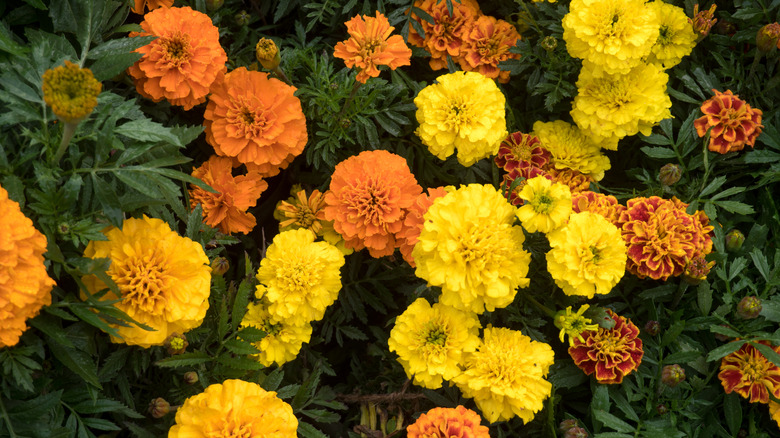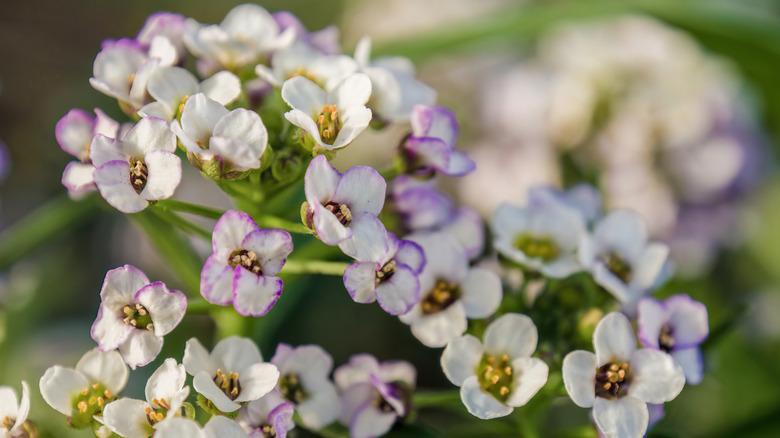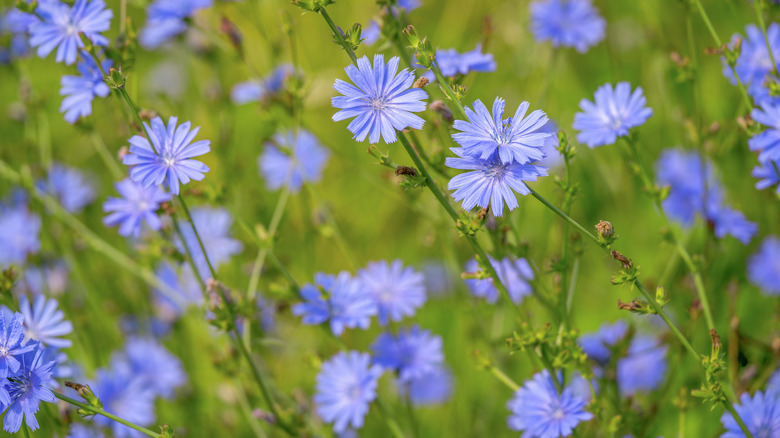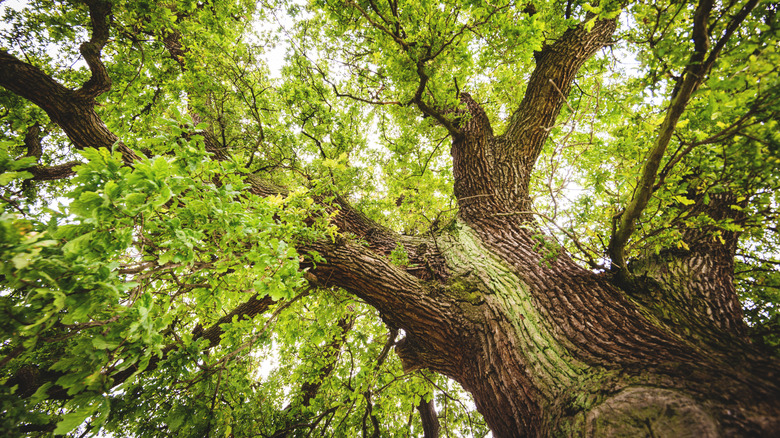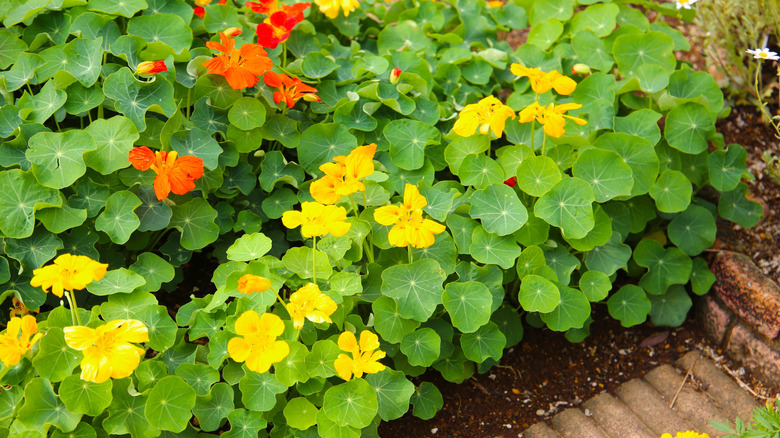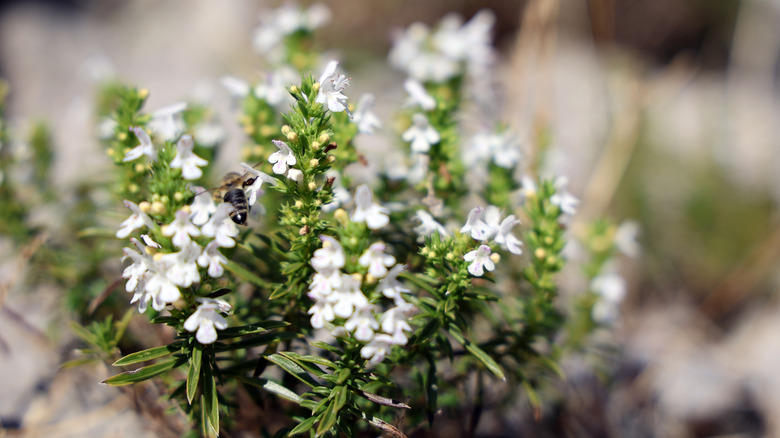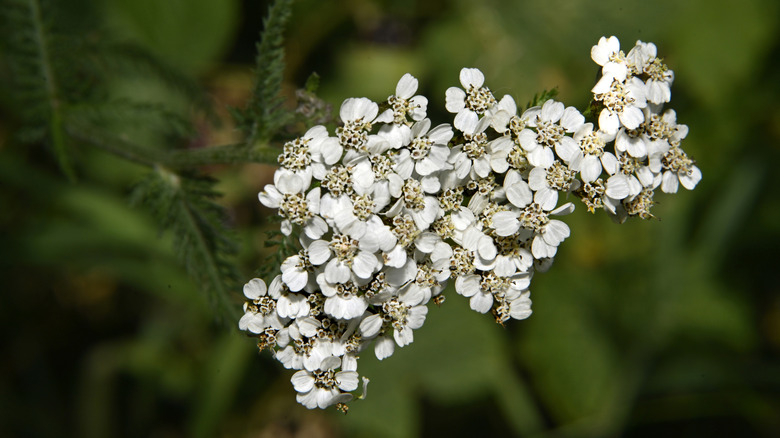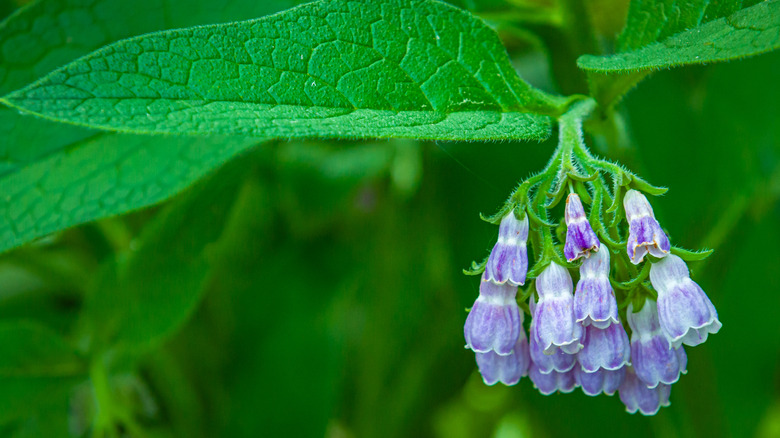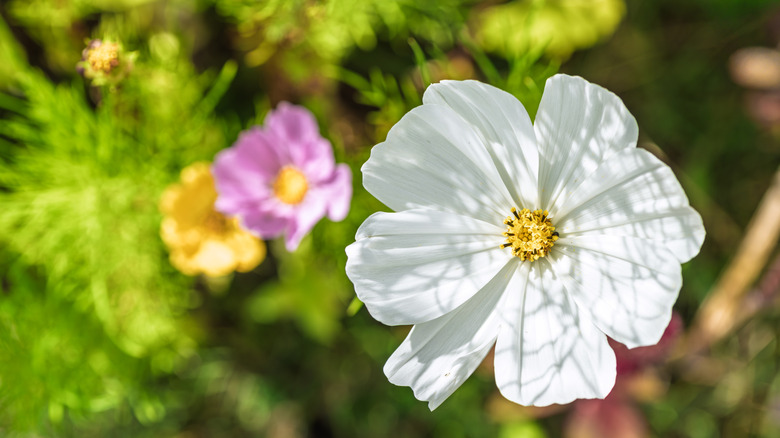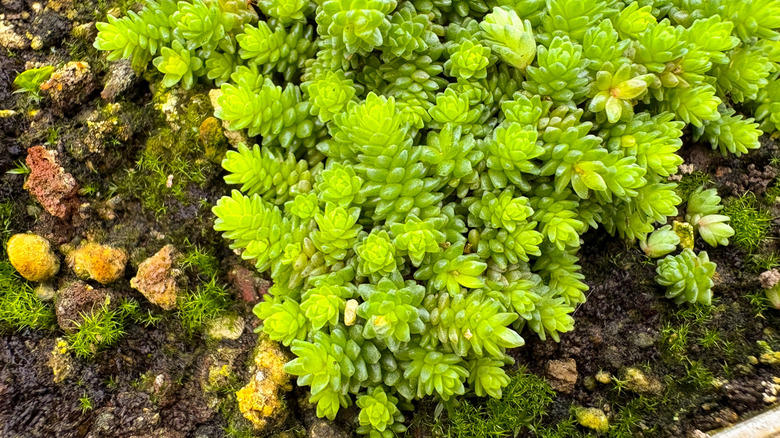15 Beautiful Companion Plants To Grow With Evergreen Shrubs
Evergreen shrubs are dependable and practical plants. They keep their color throughout the year, and depending on the ones you choose, some can provide background interest while others can act as natural privacy screens. And since evergreen shrubs last for years, sooner or later, they will need some sort of care. Fertilizer, pesticide, or maybe something else. That is where companion plants can help. Some of them naturally help your evergreen shrubs by keeping the beneficial insects close and nasty bugs away. Examples of such beautiful companion plants include thyme, nasturtium, and marigolds.
Some others, like shade-loving evergreen shrubs like rhododendrons, can be paired with oaks and pines as canopy plants. Likewise, if you are growing an evergreen flowering shrub that blooms and produces fruit, you will definitely want something that attracts pollinators like sweet alyssum. And if you have an evergreen shrub that needs rich and fertile soil, you could consider planting companion plants in your garden that naturally enrich the soil.
Marigolds
Marigolds (Tagetes spp.) are mighty annual or perennial plants loved for their golden, cheerful flowers. They are durable in landscapes and pretty easy to grow. They offer benefits like nematode suppression, which often affects evergreen shrubs like boxwoods and gardenias. Similarly, marigolds are also exceptional deterrents of beetles. And with their pungent aroma, marigolds can even help keep away herbivores like rabbits and deer that otherwise might munch on your favorite shrubs. The best part is that marigolds are hardy plants, and you can grow them pretty much everywhere in the U.S., from USDA Hardiness Zones 2 to 11.
Tickseed
If you are looking for a companion plant for your flowering evergreen shrub, tickseed, also known as common coreopsis (Coreopsis grandiflora), is a fantastic choice. It provides safeguard habitats, shelter, and food for pollinators and is perfect for water-wise perennial gardens because of its drought tolerance. Furthermore, its bright yellow flowers really stand out, especially against the green of an evergreen, and if you give it the right conditions, it will bloom steadily from late spring to late summer. You can plant it in zones 5 to 9 — just make sure that the site gets plenty of sun.
White clover
A mat-forming perennial white clover (Trifolium repens; hardy in zones 3 to 10) is a good companion to go under dense evergreen shrubs thanks to its shade-tolerance. Since it also withstands repeated mowings and heavy foot traffic, you can also use it as a groundcover under your shrub. It is more colorful than grass, and when it blooms with its white flowers, it will attract plenty of pollinators. But its real benefit comes from the ability to enrich soil, prevent erosion, and suppress weed growth, which can all help your evergreen shrubs.
Sweet Alyssum
Sweet alyssum (Lobularia maritima) is often used to create flower edges in gardens. And while its use as an attractive ornamental plant in zones 5 to 9 is well known, its companion plant benefits other than attracting pollinators are still a mystery to many. For instance, it grows low and has a spreading habit, and works great as a living mulch, which can help conserve soil moisture and reduce weeds. In addition, beneficial insects like parasitic wasps, lacewings, and syrphid flies, which are natural predators of many shrub pests, come running to its honey-scented flowers.
Chicory
Chicory (Cichorium intybus) is another beautiful companion plant to grow alongside evergreen shrubs with its sky-blue flowers and a mix of smooth and hairy leaves. It has large and deep roots, which can help break up compacted soil if this is a problem holding back your evergreen shrubs. If not, it also provides nectar for many pollinators in case you have planted a flowering plant or fruiting shrub in your garden. You can grow it well from zone 3 to 8 in well-drained and sunny sites, and once established, it is quite drought-tolerant too.
Oaks and pines
Oaks and pines are often used as specimen trees in landscapes. And if you choose the right kinds, they could complement your evergreen shrubs really well, as some of them also keep their leaves year-round. They work particularly well with shade-loving perennials like rhododendrons and azaleas as they form a high, lightly shaded canopy. This not only provides a gentle shade but also still lets in enough light for shrubs to grow well. Just make sure to choose the oak or pine variety that grows well in your area and look up its care and maintenance needs.
Zinnias
Zinnia (Zinnia elegans) is the companion plant if you want to create a butterfly paradise with a fast-growing flower. It comes in almost every color, including multi-tonal options. These flowers are highly appealing to pollinators. From small to large, all sorts of bees come running to zinnias; these flowers can really help your shrub if it needs to be pollinated by insects. Furthermore, deer also tend to avoid them, and they can be planted anywhere from zone 2 to 11 in loamy and rich soils.
Nasturtium
Nasturtium (Tropaeolum majus) is another companion plant for evergreen shrubs that you can grow from zone 2 to zone 11. It has flowers that pull triple duty in the backyard. They look beautiful in the garden, they are edible, so you can use them in the kitchen, and they help deter beetles, aphids, and unwanted bugs, in general. Nasturtiums can also help if you have shrubs like arborvitae (Thuja spp.), which are prone to caterpillars, by acting as a trap crop. Just make sure not to fertilize it if you want a lot of flowers.
Creeping thyme
If you have evergreen bushes like lavender and rosemary, consider creeping thyme (Thymus praecox) as a companion. It will fit perfectly at the base of the shrubby rosemary, and when paired with lavender, the purple of the lavender and the soft pink of the thyme will create a lovely visual contrast in your garden. Furthermore, its flowers are rich in nectar and attract butterflies and bees, which is definitely a good thing for flowering shrubs like lavender. You can plant it anywhere in zones 5 to 8 if you keep it out of wet soils.
Yarrow
Some evergreen shrubs, like dwarf Alberta spruce, are prone to boring insects like borer beetles, which can compromise both their look and health. For such evergreens, yarrow (Achillea millefolium) is a lifesaver. Not only does it look good with its tiny white blossoms, but it also provides a food source for braconid wasps. These wasps feed on beetle larvae and adults and will keep other harmful bugs also in check. You can plant it safely from zone 3 to 9, and the good news is that it is pretty tolerant of drought and can even thrive in poor soils.
Sundial lupine
Another great companion plant if you are growing broad-leaved evergreens that prefer rich soils is lupine. Sundial lupine (Lupinus perennis) performs best in USDA Zones 3 to 8 and prefers sandy or loamy acidic soils. Its companion plant benefits for evergreen shrubs come from its ability to fix nitrogen in the soil, which is beneficial for the surrounding plants. Other than that, it also helps neighboring plants by improving soil structure. Just don't plant it under something with dense shade, as it needs direct sunlight to thrive.
Comfrey
Comfrey (Symphytum officinale) performs best in zones 4 to 8 and has showy tubular purple flowers that attract pollinators like bees to the garden. It is pretty easy to grow, and if your evergreens are prone to deer damage, you should plant comfrey in borders in mass planting around your shrubs because it has toxic properties and deer tend to avoid it. Just don't put them directly into the ground and use containers, as they tend to stick around. Other than that, it is also a nutrient accumulator and can supply the soil with nutrients and organic material.
Cosmos
If you are looking to add a splash of color with your evergreen shrubs, cosmos (Cosmos bipinnatus) are a really good choice. They come in many different colors, so you definitely won't run out of options, and some varieties are even perennial. They don't just look beautiful, however — they are beneficial, too. They attract hoverflies, parasitic wasps, lacewings, and other beneficial predatory insects to the garden, which can help keep the numbers of plant pests in check. And the best part is that they grow fast, and you can grow them from zone 2 to 11, all over the States.
Stonecrop
Also known as roseroot, stonecrop (Sedum spp.) is often grown for its fleshy leaves and showy flowers. These flowers provide a critical source of pollen when other such sources are scarce. Other than that, it also makes a good ground cover, acting as a living mulch that can help retain soil moisture and reduce weed pressure in the garden. You can grow it reliably anywhere in zones 3 to 9, but keep in mind that sedums are not deer-resistant if that is a problem in your evergreen shrub garden.
Sage
Sage (Salvia officinalis) is an elegant aromatic herb that grows well in zones 4 to 8. It is easy to grow, too, if you just avoid the mistakes everyone makes when growing sage. Sage can help deter pests from your evergreen shrubs. It has a strong odor, which makes it difficult for pests to find their favorite food source. Other than this, sage also attracts beneficial insects that prey on the pests, reducing their number near desired plants even more. You can grow it from zone 4 to 8 in well-drained, medium to dry soils and full sun.

